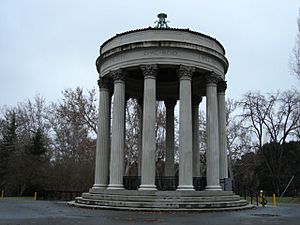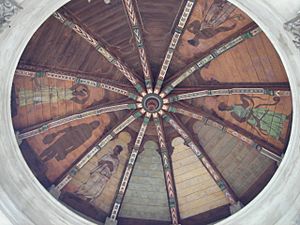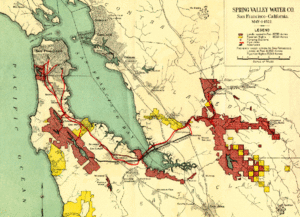Sunol Water Temple facts for kids
The Sunol Water Temple is a special building located in Sunol, California. It was designed by an architect named Willis Polk. This tall, round building is about 59 feet high. It has twelve strong concrete columns with fancy tops, like those found in ancient Greek buildings. These columns hold up a round concrete beam that supports the cone-shaped roof made of wood and tiles.
Inside the temple, water used to flow from different places, like the Pleasanton well fields. This water would go into a white-tiled pool called a cistern. From there, it would flow into a deeper channel. This channel carried water to the Niles Aqueduct, which then took the water all the way across San Francisco Bay near the Dumbarton Bridge. The roof above the cistern has paintings of Native American women carrying water pots. You can visit the temple from Monday to Friday, 9 a.m. to 3 p.m.
Contents
The Story of the Sunol Water Temple
For a long time, a private company called the Spring Valley Water Company (SVWC) owned a lot of land around the Alameda Creek area. This company was the only one providing water to San Francisco.
Why Was the Temple Built?
In 1906, a man named William Bowers Bourn II was a big owner in the SVWC. He hired Willis Polk to design the "water temple." It was built in a special spot where three water sources came together. These sources included water from the Arroyo de la Laguna, water from Alameda Creek that had been filtered through underground tunnels, and water from deep wells in Pleasanton.
Some people believe Bourn wanted to sell his water company to the City of San Francisco. He might have thought the temple would make San Francisco voters want to approve the sale. Other people say that because Bourn was wealthy and well-educated, he felt it was his duty to do something good for the community.
Temple Design and Early Use
Polk designed the temple to look like the ancient Temple of Vesta in Tivoli, Italy. The Sunol Water Temple was finished in 1910. Before the Hetch Hetchy Aqueduct was built, the Sunol temple helped provide half of San Francisco's water supply. That's about 6 million gallons of water every day! In 1930, the City of San Francisco bought the SVWC, including the temple, for $40 million.
Restoring a Landmark
For many years, the Water Temple was a popular place for visitors and picnics. But by the 1980s, it was falling apart. It was badly damaged in the 1989 Loma Prieta earthquake. Some people even thought it should be torn down. The site was closed because it wasn't safe.
However, the community worked together to save it! From 1997 to 2001, the temple was repaired and made stronger to withstand earthquakes. This cost $1.2 million. After the repairs, the temple opened to the public again. Today, any water that flows through the temple is not used for drinking.
A Special Message on the Temple
The Sunol Water Temple has an important message carved into its stone. It says:
"I will make the wilderness a pool of water and the dry lands springs of water. [Isaiah 41:18] The streams whereof shall make glad the city. [psalms 46:4] S.V.W.C. MCMX [Spring Valley Water Company 1910]"
This message talks about bringing water to dry places and making cities happy with its streams. It also shows that the Spring Valley Water Company built it in 1910.
Images for kids
See also
 In Spanish: Sunol Water Temple para niños
In Spanish: Sunol Water Temple para niños





